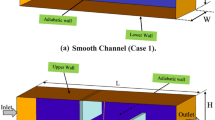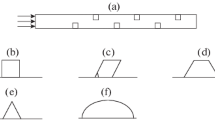Abstract
The heat transfer characteristics were experimentally investigated in a wind channel with different types of cut baffles for heat transfer augmentation. The aim of using zigzag-cut baffles is to create 3D flow structure behind the baffles instead of transverse vortex flow leading to enhance heat transfer. In this study, 4 types of baffles were examined; conventional baffle (Rectangular cross section with no cut), baffle with rectangular zigzag-cut, baffle with triangle zigzag-cut at 45 degree and at 90 degree. All of the baffles have the same height at H = 15 mm and flow blocking area. In the experiment, the row of seven baffles was attached on the inner surface of wind channel. The effects of pitch spacing length were also investigated at baffle pitch distance P/H = 4, 6 and 8 (H: Height of baffle). The experiments were performed at constant Reynolds number (Re) of 20000. The heat transfer patterns via Thermochromic liquid crystal sheet were visualized and recorded with a digital camera. The recorded images were then analyzed with image processing technique to obtain the distribution of Nusselt number. The flow characteristics pass through the baffles were also numerically studied with CFD simulation for understanding the heat transfer characteristics. The friction losses were measured to evaluate the thermal performance for each baffle. It was found that the baffle with rectangular zigzag-cut gives the best thermal performance due to heat transfer augmentation in upstream and downstream side of baffle.
Similar content being viewed by others
References
G. Rau, The blockage effect of turbulators in a rectilinear cooling channel, Heat Transfer and Cooling in Gas Turbines, VKI Lecture Series 05 (1995).
J. C. Han and S. Dutta, Internal convection heat transfer cooling: An experiment approach, Proceeding of the 5th Heat Transfer and Cooling in Gas Turbine, Belgium (1995).
K. Y. Kim and S. S. Kim, Shape optimization of rib-roughened surface to enhance turbulent heat transfer, International Journal of Heat and Mass Transfer, 45 (2002) 2719–2727.
Nasiruddind and M. H. S. Kamran, Heat transfer augmentation in a heat exchanger tube using a baffle, International Journal of Heat and Fluid Flow, 28 (2007) 318–328.
P. Promvonge, S. Sripattanapipat, S. Tamna, S. Kwankaomeng and C. Thianpong, Numerical investigation of laminar heat transfer in a square channel with 45° inclined baffles, International Communications in Heat and Mass Transfer, 37 (2010) 170–177.
S. Kwankaomeng and P. Promvonge, Numerical prediction on laminar heat transfer in square duct with 30° angled baffle on one wall, International Communications in Heat and Mass Transfer, 37 (2010) 857–866.
S. Eiamsa-ard and P. Promvonge, Laminar periodic flow and heat transfer in a rectangular channel with triangular wavy baffles, Journal of Thermal Science, 21 (2012) 250–261.
P. Promvonge, W. Jedsadaratanachai, S. Kwankaomeng and C. Thianpong, 3D Simulation of laminar flow and heat transfer in V-baffled square channel, International Communications in Heat and Mass Transfer, 39 (2012) 85–93.
P. Promvonge, W. Changcharoen, S. Kwankaomeng and C. Thianpong, Numerical heat transfer study of turbulent square-duct flow through inline V-shaped discrete ribs, International Communications in Heat and Mass Transfer, 38 (2011) 1392–1399.
B. K. P. Ary, M. S. Lee, S. W. Ahn and D. H. Lee, The effect of the inclined perforated baffle on heat transfer and flow patterns in the channel, International Communications in Heat and Mass Transfer, 39 (2012) 1578–1583.
P. Sriromreun, C. Thianpong and P. Promvonge, Experimental and numerical study on heat transfer enhancement in a channel with Z-shaped baffles, International Communications in Heat and Mass Transfer, 39 (2012) 945–952.
A. A. Rezwan, S. Hossain, S. M. A. Rahman and M. A. Islam, Heat transfer enhancement in an air process heater using semi-circular hollow baffles, Procedia Engineering, 56 (2013) 357–362.
M. Wae-hayee, P. Tekasakul and C. Nuntadusit, Influence of nozzle arrangement on flow and heat transfer characteristics for arrays of circular impinging jets, Songklanakarin Journal of Science and Technology, 35 (2012) 203–212.
F. P. Incropera, D. P. Dewitt, T. L. Bergman and A. S. Lavine, Introduction to Heat Transfer, Fifth Edition, John Wiley & Sons (2007) 530–541.
L. F. G. Geers, M. J. Tummers, T. J. Bueninck and K. Hanjalic, Heat transfer correlation for hexagonal and in-line arrays of impinging jets, International Journal of Heat and Mass Transfer, 51 (2008) 5389–5399.
S. J. Kline and F. A. McClintock, Describing uncertainties in single-example experiments, Mechanical Engineering, 75 (1953) 3–8.
X. Gao and B. Sunden, Heat transfer and pressure drop measurements in rib-roughened rectangular ducts, Experimental Thermal and Fluid Science, 24 (2001) 25–34.
S. M. Salim and S. C. Cheah, Wall y+ strategy for dealing with wall-bounded turbulent flows, The International Multi-Conference of Engineers and Computer Scientists (IMECS), March 18–20, Hong Kong (2009).
M. W. Heo, K. D. Lee and K. Y. Kim, Optimization of an inclined elliptic impinging jet with cross flow for enhancing heat transfer, Heat Mass Transfer, 47 (2011) 731–742.
T. T. Chandratilleke, D. Jagannatha and R. Narayanaswamy, Heat transfer emhancement in microchannels with cross-flow synthetic jets, International Journal of Thermal Sciences, 49 (2010) 504–513.
Author information
Authors and Affiliations
Additional information
Recommended by Associate Editor Dae Hee Lee
Chayut Nuntadusit is an Assistant Professor of Mechanical Engineering at Prince of Songkla University, Thailand. He received Ph.D. at Osaka University in 2004. His current interests include heat transfer enhancement for jet impingement, jet flow control and optical measurement.
Ibroheng Piya is fellow at Department of Mechanical Engineering, Faculty of Engineering, Princess of Naradhiwas University, Thailand. He received Master of Engineering in Mechanical Engineering from Prince of Songkla University, Thailand in 2013. His research includes flow and heat transfer engineering and computational fluid dynamics.
Makatar Wae-hayee is a postdoctoral researcher of Mechanical Engineering at the Department of Mechanical Engineering, Faculty of Engineering, Prince of Songkla University, Thailand. He received Ph.D. at the same university in 2014. He concerns in flow and heat transfer of impinging jet, rib, pin fin and etc.
Smith Eiamsa-ard is an Associate Professor of Mechanical Engineering at Mahanakorn University of Technology (MUT), Thailand. He obtained his D.Eng. in Mechanical Engineering from King Mongkut’s Institute of Technology Ladkrabang. He has been working at MUT since 1996. His research interests include Thermal&Fluid engineering, heat transfer enhancement and computational fluid dynamics.
Rights and permissions
About this article
Cite this article
Nuntadusit, C., Piya, I., Wae-hayee, M. et al. Heat transfer characteristics in a channel fitted with zigzag-cut baffles. J Mech Sci Technol 29, 2547–2554 (2015). https://doi.org/10.1007/s12206-015-0552-9
Received:
Revised:
Accepted:
Published:
Issue Date:
DOI: https://doi.org/10.1007/s12206-015-0552-9




